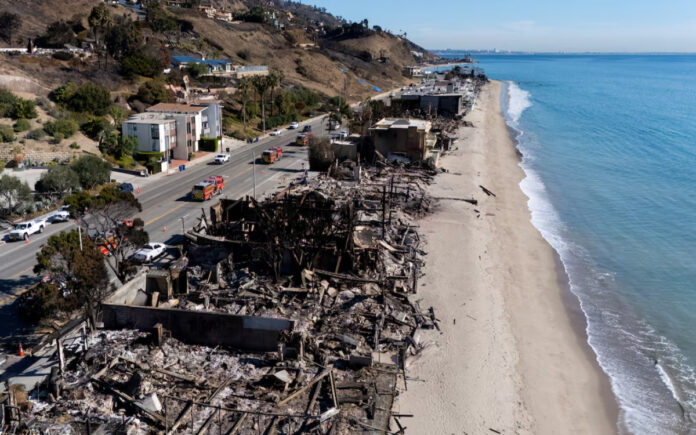Los Angeles, California: Los Angeles officials have informed most evacuees from the wildfires that they must stay away from their homes for at least another week. Emergency responders are working to remove toxic waste from incinerated neighborhoods while cutting off electricity and gas lines, which pose significant hazards in the aftermath of the destruction.
Landslides have further complicated recovery efforts, endangering the already devastated hillsides. Leveled structures no longer anchor the earth, and water from fire hoses and broken pipes has saturated the ground, adding to the stress of people enduring what is considered the worst natural disaster in the city’s history.
Wildfires, now raging for the 10th day, have prompted some relief among firefighters, as recent red flag conditions, which brought high desert winds and low humidity, have not caused the two major fires to expand. However, the National Weather Service warned that the temporary respite, provided by ocean breezes and cloud cover, would be short-lived. Hazardous fire weather is expected to return by Sunday.
While many evacuees are desperate to return home to assess damage or retrieve valuables, officials insist it remains too dangerous. They have also emphasized that the ongoing risks make it impossible for first responders to focus on anything but the immediate disaster response, which has claimed at least 27 lives.
Frank McGrath, 46, who was at a disaster center in Pasadena on Thursday, is among those whose lives have been upended. He, his wife Bridget, and their 9-year-old daughter lost their home in the Eaton fire and are currently staying with Bridget’s mother. McGrath, a film and television editor, expressed the frustration of wanting to return and sift through the rubble for cherished family heirlooms but understands the hazards involved.
“Is my wedding ring somewhere buried?” he said, reflecting on the uncertainty of what, if anything, survived. “There are clearly some hazardous materials in there. We want to get in, but we understand why it’s limited.”
For others, the toxic ash left behind by the fires has made returning to homes impossible. Melanie Alonso, 28, a behavioral therapist from Altadena, explained that even though her house survived, the thick layers of ash make it uninhabitable. Insurance companies have instructed homeowners like Alonso not to begin cleanup until the properties are inspected.
“It’s like there is an ashtray up your nose,” Alonso said while standing on her street Thursday. “Insurance is like don’t start cleaning your house. We were supposed to be back after a day, then a week…”
Los Angeles Mayor Karen Bass noted the emotional toll the disaster has taken on residents. “You can see the emotional toll that this disaster has taken on people, as I spoke to people who had lost their homes or who were not sure the status of their homes or missing pets. The toll you can see mounting on them.”
As of Thursday, the Palisades fire had consumed 23,713 acres (96 sq km) and was 27% contained, while the Eaton fire, which burned 14,117 acres (57 sq km) in the foothills east of Los Angeles, was 55% contained, according to Cal Fire. Together, the two fires have scorched an area of 59 sq miles (152 sq km), larger than Paris or nearly three times the size of Manhattan. A series of smaller wildfires in Southern California have been brought under control.
The fires have destroyed or severely damaged at least 12,000 structures, many of them homes, and left 82,400 people under evacuation orders, with another 90,400 under evacuation warnings. Some residents defied evacuation orders and died, while others risked their own safety to protect their neighbors’ homes.
John Carr, a resident of Pacific Palisades, chose to remain in his home to protect it from the fire. As the flames encroached on his property, Carr battled the blaze by jumping fences and using his hose to fight the flames.
Also Read | Taiwan’s First Execution in Five Years Stirs Controversy with EU and Human Rights Advocates
“I was awake all night, all day. I got a little bit of sleep after things calmed down a little bit, after all the houses all burned down. I did probably hurt a rib jumping a fence over there,” Carr said. “Some things in life are worth fighting for, you know.”
Los Angeles County officials stated that some people in evacuation zones might be allowed to return home sooner than a week, but others may face even longer delays, especially as efforts to recover and identify human remains continue. The removal of hazardous materials from damaged or destroyed homes by the U.S. Environmental Protection Agency must be completed before debris can be cleared and utilities restored.
Also Read | North Korea Condemns US Aircraft Deployments Over Korean Peninsula
Mark Pestrella, director of Los Angeles County Public Works, noted that the flood control system, clogged with debris and toxic materials, needs to be cleared before expected rains arrive after a prolonged dry spell.
Police had attempted to escort evacuees to their homes for brief visits, but this created obstructions for fire trucks and diverted valuable resources, according to Los Angeles Police Chief Jim McDonnell.
Also Read | SpaceX’s Starship Explodes During Test Flight, Disrupting Air Traffic
Beyond immediate recovery, state and local officials are preparing for a massive reconstruction effort. To avoid delays, they are suspending certain regulations. Private forecaster AccuWeather estimates damage and losses could surpass $250 billion, making these wildfires the costliest natural disaster in U.S. history.
The devastation has also disrupted preparations for major upcoming events in Los Angeles, including parts of the 2026 World Cup, the 2027 Super Bowl, and the 2028 Olympic Games. However, experts indicate that the relocation of the Olympics is unlikely.



